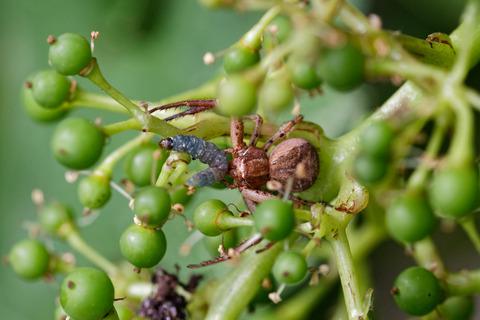当前位置:
X-MOL 学术
›
Funct. Ecol.
›
论文详情
Our official English website, www.x-mol.net, welcomes your
feedback! (Note: you will need to create a separate account there.)
The shape of the predator biomass distribution affects biological pest control services in agricultural landscapes
Functional Ecology ( IF 4.6 ) Pub Date : 2020-09-23 , DOI: 10.1111/1365-2435.13684 Noémie Ostandie 1 , Lucile Muneret 1, 2 , Brice Giffard 1 , Denis Thiéry 1 , Adrien Rusch 1
中文翻译:

捕食者生物量分布的形状影响农业景观中的生物虫害防治服务
更新日期:2020-09-23
Functional Ecology ( IF 4.6 ) Pub Date : 2020-09-23 , DOI: 10.1111/1365-2435.13684 Noémie Ostandie 1 , Lucile Muneret 1, 2 , Brice Giffard 1 , Denis Thiéry 1 , Adrien Rusch 1
Affiliation

|
- Understanding how community composition of service‐providing organisms affects ecosystem functioning is a key challenge in ecology. Although it has been proposed that taxonomic diversity and functional traits mediate this relationship, how several facets of community structure affect the delivery of key ecosystem services remains to be explored.
- In this study, we investigated how abundance, taxonomic richness as well as the shape of biomass distribution in predator communities affect biological pest control services in vineyard landscapes. Our analyses were based on a dataset combining samples of arthropod predators, measures of predation rates of grape pests and characterization of environmental covariables for 42 fields located in South‐Western France.
- We found that beside the abundance or the taxonomic richness of predators, the shape of biomass distribution (mean, variance, skewness and kurtosis of the distribution) influences the level of biological control. Predator communities largely dominated by low biomass species provided the bulk of biological control services. Lower levels of predation resulted from increased proportions of large biomass species and more evenly distributed biomass values in the communities.
- Our results indicate that the top‐down control provided by low biomass species decreases as the relative proportion of large biomass species increases in the predator community. This suggests that biological control may be affected by negative interactions (e.g. intraguild predation, behavioural interactions) between predators arising from the recruitment of large individuals in the community.
- Our study revealed that the shape of biomass distribution is a major aspect of functional diversity in predator communities providing insights into the mechanisms that link biodiversity and ecosystem services. While our study focuses on biomass, considering other traits involved in trophic interactions may increase our ability to predict the level of biological control in ecosystems.
中文翻译:

捕食者生物量分布的形状影响农业景观中的生物虫害防治服务
- 了解提供服务的有机体的社区组成如何影响生态系统功能是生态学中的关键挑战。尽管已经提出生物分类多样性和功能性特征介导这种关系,但是社区结构的几个方面如何影响关键生态系统服务的交付仍有待探索。
- 在这项研究中,我们调查了捕食者群落的丰度,分类学丰富度以及生物量分布的形状如何影响葡萄园景观中的生物害虫防治服务。我们的分析是基于一个数据集,该数据集包括节肢动物捕食者的样本,葡萄虫害的捕食率的测量以及法国西南部42个田地的环境协变量特征。
- 我们发现,除了捕食者的种类丰富或分类丰富外,生物量分布的形状(分布的均值,方差,偏度和峰度)也会影响生物控制水平。以低生物量物种为主的捕食者群落提供了大量生物防治服务。较低的捕食水平是由于大型生物量物种的比例增加以及社区中生物量值更均匀地分布所致。
- 我们的结果表明,低生物量物种提供的自顶向下控制随着捕食者群落中大生物量物种的相对比例的增加而降低。这表明生物控制可能受到社区中大批个体招募引起的掠食者之间负面互动(例如行会内掠食,行为互动)的影响。
- 我们的研究表明,生物多样性分布的形状是捕食者社区功能多样性的主要方面,提供了将生物多样性与生态系统服务联系起来的机制的见解。尽管我们的研究重点是生物量,但考虑到营养相互作用中涉及的其他特征可能会提高我们预测生态系统中生物控制水平的能力。











































 京公网安备 11010802027423号
京公网安备 11010802027423号